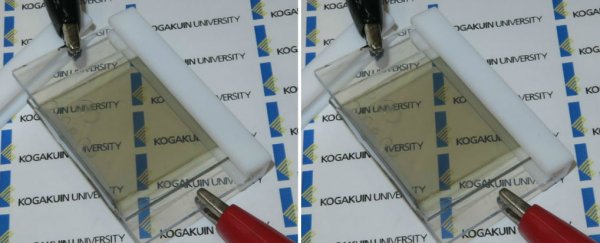Researchers in Japan have invented a rechargeable lithium-ion battery that can charge itself using sunlight - no solar cell required.
The working prototype was demonstrated at the Innovation Japan 2015 trade show last month in Tokyo, and the team behind it hopes to see the technology integrated into a 'smart window' that can act as both a large rechargeable battery and a photovoltaic cell all at once.
The team, led by Mitsunobu Sato, professor at the Department of Applied Physics at Kogakuin University in Japan, announced the development of this device back in 2013. They've since been working towards a battery-integrated window that can store energy from sunlight while also changing its structure automatically to provide a tint during the day.
According to Bob Yirka at techxplore, when the battery is exposed to sunlight, it becomes tinted to about 30 percent light transmittance, and this allows the energy to be captured more efficiently.
"The trick in getting them to be nearly transparent is in making them really thin - the electrodes are just 80 nm and 90 nm," says Yirka. "After discharge, the team reports that light transmittance rises to approximately 60 percent."
How did they make the electrodes so thin? Back in 2013, the main component of the electrolyte for the battery's positive electrode was lithium iron phosphate, and for the electrolyte used for the negative electrode, they used lithium titanate and lithium hexafluorophosphate - both of which are commonly used in rechargeable lithium-ion batteries.
For the prototype that was put on display in Tokyo last month, they altered the transparent oxides used for the negative electrode to achieve incredibly thin, transparent electrodes. While they're yet to publish details on what these changes were, they were able to facilitate charging via sunlight or other bright sources of illumination.
In testing, the team reports an output from the battery of 3.6 volts, and say they managed to successfully complete 20 charge/discharge cycles.
While the prospect of smart windows is what's got Sato and his team excited, another possibility for the technology is self-charging smartphone screens made from transparent lithium-ion batteries. They'll just have to compete with these guys from Michigan State University in the US, who are working on something very similar.
